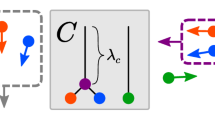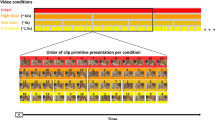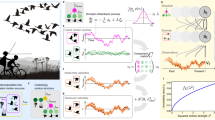Abstract
Humans have an inherent tendency to infer other people's intentions from their actions. Here we review psychophysical and functional neuroimaging evidence that biological motion is processed as a special category, from which we automatically infer mental states such as intention. The mechanism underlying the attribution of intentions to actions might rely on simulating the observed action and mapping it onto representations of our own intentions. There is accumulating neurophysiological evidence to support a role for action simulation in the brain.
Key Points
-
Humans have an inherent ability to understand other people's minds. This process is a component of a 'theory of mind'. This review focuses on a low level of theory of mind — the ability to understand other people's intentions by observing their actions. This ability might be a prerequisite for the higher-level understanding of others' minds.
-
Psychophysical studies show that biological motion is processed as a special category, to which humans from an early age attribute mental states such as intention. The posterior superior temporal sulcus (STS) is involved in the detection of biological motion. This area receives convergent information from both dorsal and ventral visual streams, making it an interface between perception for identification and perception for action.
-
Humans attribute intentions to basic stimuli, including dynamic point-light displays and simple animations, as long as their movement is 'animate' — that is, it is self-propelled, its path may be nonlinear and it may undergo sudden changes of velocity. The STS and the medial prefrontal cortex are activated when mental states are attributed to moving shape stimuli. These areas are also consistently activated by higher-level theory-of-mind tasks in which subjects think about their own or others' mental states.
-
A mechanism for inferring intentions from observed actions is proposed that depends on the same 'forward model' system that labels the consequences of one's own actions as being produced by one's own intentions. Forward models store predictions of the consequences of one's own actions. These stored representations could be recruited when observing someone else's movements to estimate their intentions.
-
This mechanism may be based on simulating the observed action and estimating the actor's intentions based on a representation of one's own intentions, an idea that is reminiscent of simulation theory. There is evidence that simulation and imitation — a case of overt action simulation — facilitate intentional attribution. In particular, neurophysiological evidence supports the existence of a matching system between perception and action, which is recruited during imitation.
-
Psychophysical and neurophysiological studies support the idea that the brain is a powerful simulating machine, designed to detect biological motion in order to extract intentions from the motion and to predict the future actions of other animate beings.
This is a preview of subscription content, access via your institution
Access options
Subscribe to this journal
Receive 12 print issues and online access
$189.00 per year
only $15.75 per issue
Buy this article
- Purchase on Springer Link
- Instant access to full article PDF
Prices may be subject to local taxes which are calculated during checkout


Similar content being viewed by others
References
Carruthers, P. & Smith, P. K. (eds) Theories of Theories of Mind (Cambridge Univ. Press, Cambridge, UK, 1996).
Goldman, A. I. In defense of simulation theory. Mind Lang. 7, 104–119 (1992).
Gordon, R. M. in Theories of Theories of Mind (eds Carruthers, P. & Smith, P. K.) 11–21 (Cambridge Univ. Press, Cambridge, UK, 1996).
Johansson, G. Visual perception of biological motion and a model for its analysis. Percept. Psychophys. 14, 201–211 (1973).
Koslowski, L. T. & Cutting, J. E. Recognising the sex of a walker from point-lights mounted on ankles: some second thoughts. Percept. Psychophys. 23, 459 (1978).
Dittrich, W. H., Troscianko, T., Lea, S. E. & Morgan, D. Perception of emotion from dynamic point-light displays represented in dance. Perception 25, 727–738 (1996).
Fox, R. & McDaniel, C. The perception of biological motion by human infants. Science 218, 486–487 (1982).
Bertenthal, B. I. in Visual Perception and Cognition in Infancy (ed. Granrud, C.) 175–214 (Erlbaum, Hullsdale, New Jersey, 1993).
Goodale, M. A. & Milner, A. D. Separate visual pathways for perception and action. Trends Neurosci. 15, 20–25 (1992).
Baizer, J., Ungerleider, L. & Desimone, R. Organization of visual inputs to the inferior temporal and posterior parietal cortex in macaque. J. Neurosci. 11, 168–190 (1991).
Oram, M. W. & Perrett, D. I. Responses of anterior superior temporal polysensory (STPa) neurons to biological motion stimuli. J. Cogn. Neurosci. 6, 99–116 (1994).
Grossman, E. et al. Brain areas involved in perception of biological motion. J. Cogn. Neurosci. 12, 711–720 (2000).
Grèzes, J. et al. Does perception of biological motion rely on specific brain regions? Neuroimage 13, 775–785 (2001).
Grossman, E. & Blake, R. Brain activity evoked by inverted and imagined motion. Vision Res. 41, 1475–1482 (2001).
Rizzolatti, G. et al. Localization of grasp representations in humans by PET. 1. Observation versus execution. Exp. Brain Res. 111, 246–252 (1996).
Puce, A., Allison, T., Bentin, S., Gore, J. C. & McCarthy, G. Temporal cortex activation in humans viewing eye and mouth movements. J. Neurosci. 18, 2188–2199 (1998).
Wicker, B., Michel, F., Henaff, M. A. & Decety, J. Brain regions associated with mutual gaze: a PET study. Neuroimage 8, 221–227 (1998).
Freyd, J. J. in Attention and Performance XIV: Synergies in Experimental Psychology, Artificial Intelligence, and Cognitive Neuroscience (eds Meyer, D. & Kornblum, S.) 99–119 (MIT Press, Cambridge, Massachusetts, 1993).
Watson, J. D. et al. Area V5 of the human brain: evidence from a combined study using positron emission tomography and magnetic resonance imaging. Cereb. Cortex 3, 79–94 (1993).
Kourtzi, Z. & Kanwisher, N. Activation in human MT/MST by static images with implied motion. J. Cogn. Neurosci. 12, 48–55 (2000).This fMRI study found greater activation in area MT/MST when viewing static photographs with implied motion than when viewing photographs without implied motion. It is one of the first neurophysiological demonstrations that dynamic information can be extracted from still photographs.
Shiffrar, M. in Handbook of Perception (ed. Goldstein, E. B.) 238–263 (Blackwell, Oxford, 2001).
Shiffrar, M. & Freyd, J. J. Apparent motion of the human body. Psychol. Sci. 1, 257–264 (1990).
Shiffrar, M. & Freyd, J. J. Timing and apparent motion path choice with human body photographs. Psychol. Sci. 4, 379–384 (1993).An excellent demonstration of the cognitive mechanisms involved in human motion perception.
Stevens, J. A., Fonlupt, P., Shiffrar, M. A. & Decety, J. New aspects of motion perception: selective neural encoding of apparent human movements. Neuroreport 11, 109–115 (2000).
Shiffrar M. When what meets where. Curr. Dir. Psychol. Sci. 3, 96–100 (1994).
Frith, C. D. & Frith, U. Interacting minds — a biological basis. Science 286, 1692–1695 (1999).An elegant article that reviews developmental and neuroscientific studies on 'mentalizing,' and proposes that the detection of biological motion may have evolved to enable us to infer other people's mental states.
Heider, F. & Simmel, M. An experimental study of apparent behavior. Am. J. Psychol. 57, 243–249 (1944).
Kassin, K. Heider and Simmel revisited: causal attribution and the animated film technique. Rev. Pers. Soc. Psychol. 3, 145–169 (1982).
Morris, M. W. & Peng, K. Culture and cause: American and Chinese attributions for social and physical events. J. Pers. Soc. Psychol. 67, 949–971 (1994).
Gergely, G., Nadasdy, Z., Csibra, G. & Biro, S. Taking the intentional stance at 12 months of age. Cognition 56, 165–193 (1995).
Uller, C. & Nichols, S. Goal attribution in chimpanzees. Cognition 76, B27–34 (2000).This fascinating study shows that chimpanzees have an understanding of the 'goals' of two-dimensional objects in simple video displays.
Castelli, F., Happé, F., Frith, U. & Frith, C. D. Movement and mind: a functional imaging study of perception and interpretation of complex intentional movement pattern. Neuroimage 12, 314–325 (2000).
Ito, M. Neurophysiological aspects of the cerebellar motor control system. Int. J. Neurol. 7, 162–176 (1970).
Wolpert, D. M., Ghahramani, Z. & Jordan, M. I. An internal model for sensorimotor integration. Science 269, 1880–1882 (1995).
Wolpert, D. M. & Ghahramani, Z. Computational principles of movement neuroscience. Nature Neurosci. 3 (suppl.), 1212–1217 (2000).
Frith, C. D., Blakemore, S.-J. & Wolpert, D. M. Abnormalities in the awareness and control of action. Phil. Trans. R. Soc. Lond. B 355, 1771–1788 (2000).
Von Holst, E. Relations between the central nervous system and the peripheral organs. Br. J. Anim. Behav. 2, 89–94 (1954).
Miall, R. C. & Wolpert, D. M. Forward models for physiological motor control. Neural Netw. 9, 1265–1279 (1996).
Wolpert, D. M. Computational approaches to motor control. Trends Cogn. Sci. 1, 209–216 (1997).
Wolpert, D. M. & Kawato, M. Multiple paired forward and inverse models for motor control. Neural Netw. 11, 1317–1329 (1998).
Blakemore, S.-J., Frith, C. D. & Wolpert, D. W. Spatiotemporal prediction modulates the perception of self-produced stimuli. J. Cogn. Neurosci. 11, 551–559 (1999).
Jiang, W., Chapman, C. E. & Lamarre, Y. Modulation of the cutaneous responsiveness of neurones in the primary somatosensory cortex during conditioned arm movements in the monkey. Exp. Brain Res. 84, 342–354 (1991).
Chapman, C. E. & Ageranioti-Belanger, S. A. Comparison of the discharge of primary somatosensory cortical (SI) neurones during active and passive tactile discrimination. Proc. Third IBRO World Cong. Neurosci. 317 (1991).
Chapman, C. E. Active versus passive touch: factors influencing the transmission of somatosensory signals to primary somatosensory cortex. Can. J. Physiol. Pharmacol. 72, 558–570 (1994).
Blakemore, S.-J., Wolpert, D. M. & Frith, C. D. Central cancellation of self-produced tickle sensation. Nature Neurosci. 1, 635–640 (1998).
Numminen, J., Salmelin, R. & Hari, R. Subject's own speech reduces reactivity of the human auditory cortex. Neurosci. Lett. 265, 119–122 (1999).
Curio, G., Neuloh, G., Numminen, J., Jousmaki, V. & Hari, R. Speaking modifies voice-evoked activity in the human auditory cortex. Hum. Brain Mapp. 9, 183–191 (2000).A magnetoencephalographic study revealing differential responses in human auditory cortex to self-uttered speech compared with listening to a replay of the same speech.
Imamizu, H. et al. Human cerebellar activity reflecting an acquired internal model of a new tool. Nature 403, 192–195 (2000).An fMRI study in which subjects learned to use a novel tool. The results show that the cerebellum acquires internal models of objects in the external world.
Wolpert, D. M., Miall, R. C. & Kawato, M. Internal models in the cerebellum. Trends Cogn. Sci. 2, 338–347 (1998).
Blakemore, S.-J., Frith, C. D. & Wolpert, D. W. The cerebellum is involved in predicting the sensory consequences of action. Neuroreport 12, 1879–1885 (2001).
Miall, R. C., Weir, D. J., Wolpert, D. M. & Stein, J. F. Is the cerebellum a Smith predictor? J. Mot. Behav. 25, 203–216 (1993).
Hume, D. Treatise of Human Nature (Oxford University Press, Oxford, 1978).
Gordon, R. M. in Mind and Morals: Essays on Ethics and Cognitive Science (eds May, L., Friedman, M. & Clark, A.) 165–180 (MIT Press, Cambridge, Massachusetts, 1996).
Meltzoff, A. N. & Moore, M. K. in Body and the Self (eds Bermúdez, J., Marcel, A. J. & Eilan, N.) 43–69 (MIT Press, Cambridge, Massachusetts, 1995).
Prinz, W. Perception and action planning. Eur. J. Cogn. Psychol. 9, 129–154 (1997).
Shepard, R. N. Ecological constraints on internal representations: resonant kinematics of perceiving, imagining, thinking, and dreaming. Psychol. Rev. 91, 417–447 (1984).
Barresi, J. & Moore, C. Intentional relations and social understanding. Behav. Brain Sci. 19, 107–154 (1996).An interesting cognitive model that attempts to explain how social organisms represent the intentional relations of themselves and other agents.
Gallese, V., Fadiga, L., Fogassi, L. & Rizzolatti, G. Action recognition in the premotor cortex. Brain 119, 593–609 (1996).
Gallese, V. & Goldman, A. Mirror neurons and the simulation theory of mind reading. Trends Cogn. Sci. 2, 493–501 (1998).
Decety, J. et al. Mapping motor representations with PET. Nature 371, 600–602 (1994).
Decety, J. et al. Brain activity during observation of actions. Influence of action content and subject's strategy. Brain 120, 1763–1777 (1997).
Ruby, P. & Decety, J. Effect of the subjective perspective taking during simulation of action: a PET investigation of agency. Nature Neurosci. 4, 546–550 (2001).
Fadiga, L., Fogassi, L., Pavesi, G. & Rizzolatti, G. Motor facilitation during action observation: a magnetic stimulation study. J. Neurophysiol. 73, 2608–2611 (1995).An important demonstration using TMS of increased activity in the motor system during the observation of actions.
Grèzes, J., Costes, N. & Decety, J. Top down effect of the strategy to imitate on the brain areas engaged in perception of biological motion: a PET investigation. Cogn. Neuropsychol. 15, 553–582 (1998).
Hari, R. et al. Activation of human primary motor cortex during action observation: a neuromagnetic study. Proc. Natl Acad. Sci. USA 95, 15061–15065 (1998).
Buccino, G. et al. Action observation activates premotor and parietal areas in somatotopic manner: an fMRI study. Eur. J. Neurosci. 13, 400–404 (2001).An fMRI study that provides the first functional evidence for a somatotopic pattern of activation in the premotor cortex, similar to that of the classical motor cortex homunculus, elicited by the observation of actions made by another individual.
Meltzoff, A. N. & Moore, M. K. Imitation of facial and manual gestures by human neonates. Science 198, 75–78 (1977).
Meltzoff, A. N. Understanding the intentions of others: re-enactment of intended acts by 18-month-old children. Dev. Psychol. 31, 838–850 (1995).
Gopnik, A. & Meltzoff, A. N. Words, Thoughts, and Theories (MIT Press, Cambridge, Massachusetts, 1997).
Iacoboni, M. et al. Cortical mechanisms of human imitation. Science 286, 2526–2528 (1999).
Fletcher, P. C. et al. Other minds in the brain: a functional imaging study of 'theory of mind' in story comprehension. Cognition 57, 109–128 (1995).
Gallagher, H. L. et al. Reading the mind in cartoons and stories: an fMRI study of 'theory of mind' in verbal and nonverbal tasks. Neuropsychologia 38, 11–21 (2000).
Brunet E., Sarfati Y., Hardy-Bayle M. C. & Decety J. A. PET investigation of attribution of intentions to others with a non-verbal task. Neuroimage 11, 157–166 (2000).
Baron-Cohen, S., Leslie, A. M. & Frith, U. Does the autistic child have a 'Theory of Mind'? Cognition 21, 37–46 (1985).
Corcoran, R., Mercer, G. & Frith, C. D. Schizophrenia, symptomatology and social inference: investigating 'theory of mind' in people with schizophrenia. Schizophr. Res. 17, 5–13 (1995).
Happé, F. et al. 'Theory of mind' in the brain. Evidence from a PET scan study of Asperger syndrome. Neuroreport 8, 197–201 (1996).
Brunet, E., Sarfati, Y., Hardy-Baylé, M. C. & Decety, J. A PET study of the attribution of intentions to others in schizophrenia: comparison with normal subjects on a non-verbal task. Schizophr. Res. 49 (suppl.), 174 (2001).
Fink, G. R. et al. The neural consequences of conflict between intention and the senses. Brain 122, 497–512 (1999).
Acknowledgements
We thank C. Frith, D. Wolpert, J. Kilner and T. Chaminade for their comments on the manuscript. S.-J.B. is supported by a Wellcome Trust International Travelling Research Fellowship. J.D. is supported by the INSERM and by the Programme Cognitique (Principal Investigator J. Nadel) from the French Ministry of Education.
Author information
Authors and Affiliations
Supplementary information
Related links
Related links
DATABASE LINKS
MIT ENCYCLOPEDIA OF COGNITIVE SCIENCE
FURTHER INFORMATION
Glossary
- SIMULATION THEORY
-
An account by philosophers of mind, which maintains that one represents the mental activities and processes of others by simulation; that is, by generating similar activities and processes in oneself (see Ref. 53).
Rights and permissions
About this article
Cite this article
Blakemore, SJ., Decety, J. From the perception of action to the understanding of intention. Nat Rev Neurosci 2, 561–567 (2001). https://doi.org/10.1038/35086023
Issue Date:
DOI: https://doi.org/10.1038/35086023
This article is cited by
-
Inferring individual evaluation criteria for reaching trajectories with obstacle avoidance from EEG signals
Scientific Reports (2023)
-
Representational momentum of biological motion in full-body, point-light and single-dot displays
Scientific Reports (2023)
-
Sequence representations after action-imagery practice of one-finger movements are effector-independent
Psychological Research (2023)
-
Visual recognition of social signals by a tectothalamic neural circuit
Nature (2022)
-
Coupling perception to action through incidental sensory consequences of motor behaviour
Nature Reviews Psychology (2022)



